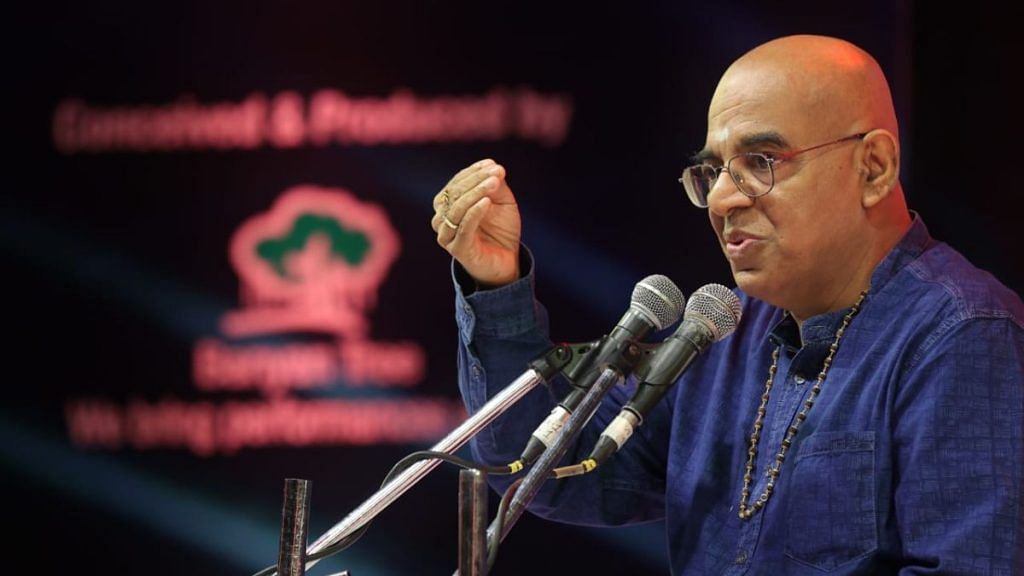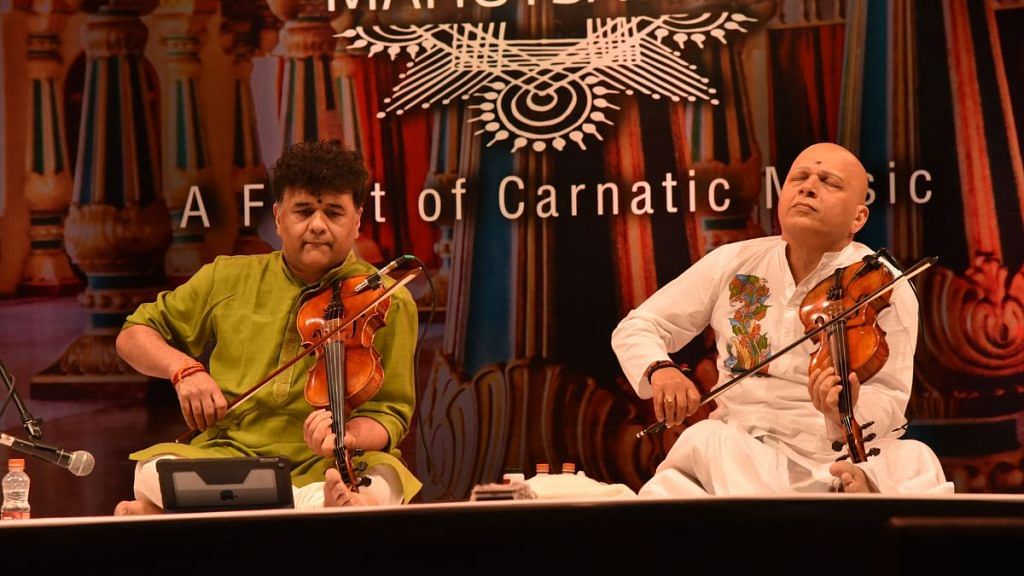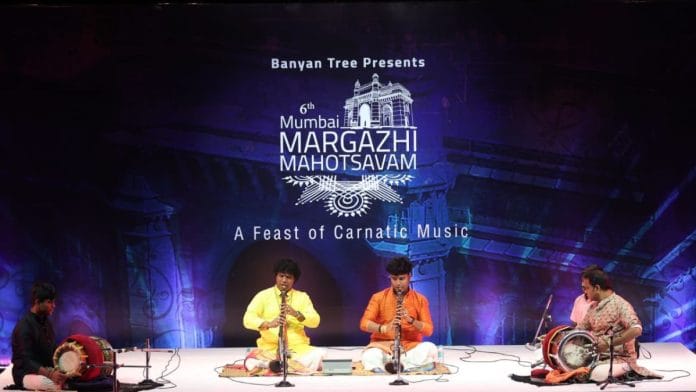Mumbai: With her head tilted on one side and eyes shut tight, the septuagenarian in a bright blue Kanchipuram sari moved her fingers rhythmically with the tala that Hindustani and Carnatic classical vocalist and violinist Sriram Parasuram was demonstrating. She hung on to every note and every word that he sang and explained.
This was not in Tamil Nadu but in the heart of Mumbai. For a brief two days, it appeared Mumbai had become mini-Chennai.
“To call oneself a ‘rasika’ — one who has knowledge of Carnatic music and appreciates the art form — one cannot be a passive listener,” Parasuram told the audience during the opening lecture-demo on identifying ragas at the sixth edition of the Mumbai Margazhi Mahotsavam.
Last weekend, St Andrew’s Auditorium in Bandra, Mumbai turned into a musical sabha of Carnatic Music kacheris organised by Banyan Tree Events and sponsored by Tata.
Among Tamilians, especially in Chennai, Margazhi is observed as the spiritual month of growth. Devotees dedicate their time to prayers, mantra japa and bhajans from 15 December to 15 January.

For the past six years, Mumbai has savoured the flavour of the Margazhi festival where Carnatic music enthusiasts, connoisseurs and eager students have flocked to the venue to listen to a stellar line-up of maestros.
This year too, three generations filled the seats in their veshtis and silk sarees, the aroma of jasmine wafting in the auditorium. Heads bobbed to the swaras, and fingers tapped to the ragas, the harkat (ornamentation) of an artist reflected in the body language of the audience.
Asha Naithani Dayama was one such ‘rasika’ in the audience. She’s never missed the festival in Mumbai. The retired Hindi literature teacher was in the company of her husband and son. “It is our yearly ritual to visit this festival together. We share a common interest in Carnatic music. The beauty of this gathering is to see artists aged 18 to 80 perform. It is a wonderful time to see younger artistes take the tradition forward,” she said.
Also read: 11-year-old Tamil ‘rock goddess’ wows America with Carnatic guitar and a headbang
A close-knit community in Mumbai
According to the 2011 Maharashtra census, the state has 5,09,887 Tamil-speaking residents. This number does not include migrants. According to the Mumbai Vizhithezhu Iyakkam, an organisation founded by Tamil people in Dharavi, there are 25 lakh people from Tamil Nadu who have settled in the slum area and other parts of Maharashtra.
Riddhi Joshi, assistant professor of history at KJ Somaiya College and city historian, said Chembur, Matunga and Sion are a mini Tamil Nadu in Mumbai. “Most of this migration happened in the 1920s and 1930s, post-World War I, when educated south Indians who spoke English language came to work in the railway offices for the British. Initially, they settled in Parel. More people came for work opportunities to Matunga or Chembur where housing was cheap. Many others who came in search of livelihood settled in Dharavi,” she said.
Since then the community has thrived in Mumbai. Three popular institutes —Tamil Sangham, Shanmukhananda and The Fine Arts Society—have helped promote Carnatic Music. “The latter hosts a three-day Carnatic music festival called Carnataka Sangeetha Vizha, along with concerts around special occasions around the year. Renowned artists like Bombay Jayashree and Trichur Brothers come to perform,” said Joshi.
Margazhi time stands out, especially for Mumbaikars who cannot go to Chennai during this period. “The community is very active when it comes to supporting Carnatic music,” said Joshi.
This is evident at the Mumbai Mahotsavam, which is organised on a much smaller scale compared to Chennai.
“This works out well for people who cannot take their parents to attend Margazhi in Chennai, which sees over 2,000 performances across venues over 21 days. In Mumbai, we have a world-class auditorium, and it attracts its loyal listeners year after year,” Mahesh Babu, founder-director of Banyan Tree Events said.
Also read: Carnatic musicians indulged TM Krishna for too long. Boycott is just a start
Nadaswaram that sings
One of the highlights this year was Sri Lanka-based Nadaswaram maestro PS Balamurugan. He was performing in the city for the first time. He shared the stage with his 22-year-old student and son PS Sarangan.
The instrument, played in temples for deities and during festive occasions, has a far-carrying, high-pitched note.
In the audience were Thane-based musician couple Mangalam Krishnan and her husband PS Krishnamoorthy, a Vaggeyakara (one who is fluent in composing and singing). The duo had returned from Chennai where they attended a few Margazhi sabhas.
“Balamurugan’s Nadaswaram has more gayaki. It was as if he was singing in Nadaswaram. There’s a space where manodharma sangeetam (imaginative artistic phrases) through kalpana swaras (innovative solfa passages) are played. That is where an artist explores his craft,” Mangalam told ThePrint
Speaking to ThePrint after his performance, Balamurugan said that playing the Nadaswaram is a matter of devotion, never for an audience.
“The only time I think of performing for an audience is during Margazhi. During this time, we share our knowledge with the next generation and plan a good performance that audiences can respond to. That is the most positive impact of Margazhi,” he said.
Between sessions, listeners also got to indulge their taste buds in south Indian delicacies from Srinivas Caterers from Mulund. From a variety of dosa, idli, sambhar rice, payasam and vada, the dining area was also filled with people waiting for their filter coffee fix.
A sizable audience returned the next day to immerse in the musical revelry. A lecture demonstration by historian Chithra Madhavan drew attention to temple architecture and iconography, while vocalist Sandeep Narayan received a standing ovation for his high-energy performance, which concluded with an electrifying Vithala dhun (tune) that the captivated audience reciprocated with synchronised claps.

The closing session was by the world-renowned violin-duo Ganesh-Kumaresh who held the audience in a raptured trance. Notes from ghatam and mridangam supported their melodies. In an interview with ThePrint, they spoke about how their music is expansive and democratised for anyone to feel connected. “That Margazhi is moving forward out of Chennai to other cities, shows our country united. The festival signifies people are open to any form of music,” said Kumaresh.
Also read: Is Chennai’s Margazhi Carnatic fest losing sheen? Empty halls, ageing fans, unpaid artists
Is the festival losing popularity?
In recent years, the popularity of the Margazhi festival in Chennai has been questioned. This fact is only partially true, said V Ramnarayan, former editor-in-chief of Sruti Magazine, a monthly performing arts magazine. “There are sabhas in every neighbourhood in Chennai today. If you take a headcount of the whole crowd, it has not come down much,” he said.
The diaspora—spread across US, Singapore, Malaysia, Sri Lanka and Europe—has played a crucial role in popularising Margazhi. They come to Chennai during this time for the love of Carnatic music. “They also support our arts by conducting festivals in their cities, featuring our artists,” added Ramnarayan.
Krishnan who flew to Mumbai from Chennai said the main difference was the duration. “Compared to Chennai, where each performance is two to three hours, sessions here are shorter, around one-and-a-half hours. However, the line-up this year is excellent.”
(Edited by Theres Sudeep)






